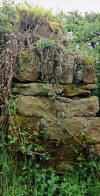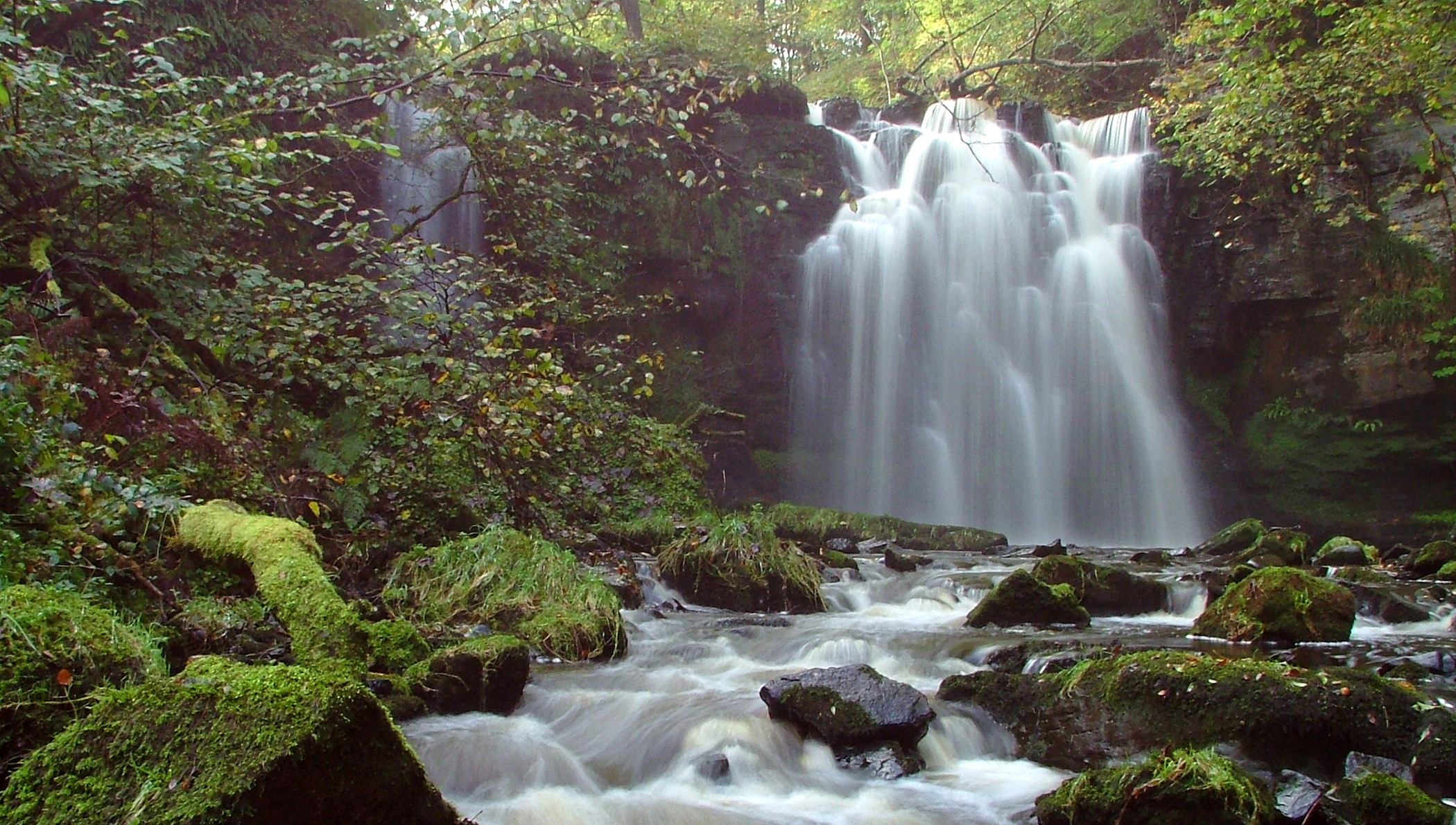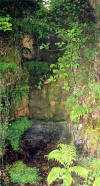|
Lynn Falls
Courtesy of Stevie Clarke of
Irvine, Ayrshire, Photographer
steviec-photography
For some outstanding photographs of Scotland and Scottish life, be sure to check out his
site!
Photos from our visit to Lynn Glen are below.
Ayrshire,
Scotland
was the location of an ancient family of Lynns who dwelt near what Ayrshire
historian James Paterson
described as a "beautiful natural cascade on the Water of Caaf, near to which
stood the ancient castle of Lin". The cascade of which
Paterson wrote
is Lynn Falls in the wooded Lynn Glen, part of the former barony of Lynn on the edge of
the town of Dalry.
Some believe that, in their earliest days, the
Lynns were vassals of the DeMorvilles.
Others tell that they were related to the English baron Hugh de Morville
and in 1204 received the Dalry lands as an inheritance. The latter view is supported by
the 1852
Imperial
Gazetteer of Scotland
and by the fact that the Lynns bore the title "of that Ilk". The right
to bear that title was granted only by royal charter and indicated that they
owned a property with the same name as the name of their family. Even if
the property was eventually sold (as did happen), the chief of the family
had the legal right to retain the title "of that Ilk" but could no longer
describe himself as lord or laird.
Their chiefs being recorded in the family papers of the Hunters of
Hunterston as lairds or lords of Lynn, as well
as superiors of Highlees, the family had acquired Highlees from
John Ross, Lord of Hawkhead and had vassals beneath them. In 1452,
they granted Highlees to the Hunters "for services rendered and to be
rendered".
It is widely reported that the
Lynns of that Ilk were an allied family of Clan Boyd. The only evidence of
a Lynn-Boyd association
in Ayrshire consists of several land transactions,
the earliest of which is the 1532 sale of part of the barony by John Lynn to Thomas Boyd.
There is no record of a Lynn-Boyd marriage in Ayrshire and no evidence
that the Lynns were vassals or a sept of the Boyds. In fact, the
Boyds themselves, while a powerful family, historically were not a
Scottish clan and only in 1988 were constituted into the House of Boyd
Society. As a result, the Lord Lyon, King of Arms, now
recognizes Boyd as a clan, but any association of Lynns with the Society
is modern only and has no basis in Scottish history.
Ancient
maps refer to the Lynns' Dalry barony as
Linn, and Paterson called its castle Lin. Both Lin and Linn, along with
Lyn, Lyne, Lynn, and Lynne, all were variant spellings
of the surname of this family. Between 1452 and 1669, however, the
family's Highlees documents shows their name written with a "y" 14 times
and with an "i" only once. Today, the falls, the glen, and an
avenue in Dalry all bear the spelling Lynn.
The Barony of Lynn
Lynn Glen, heart of the
ancient barony, is
an enchanting place, described in Ayrshire folklore as the dwelling of elves and
fairies.
With scenes such as these, it is easy to see how such tales came to be told, especially if one wanders there in the gloamin' and hears the sounds of
approaching night.
|
Lynn Falls |
William Robertson, in
his 1899 "Tales of Ayrshire," relates the story of "The Wraith of Lord
Lyne". In it, the young Lord's death is foreseen by his mother and his body
is later found at the foot of the falls. |
Our photo was taken from a poor vantage point and is grainy in appearance. We
are grateful to Stevie Clark for consent to use his stunning
photograph above. Vintage post cards, circa
1915, were imaged by Armour Hamilton and
can be seen at
http://www.dalryburnsclub.org.uk/olddalry/olddalry.html.
|
|
A Stone Column in Lynn Glen
,
the remains of which are about seven feet tall, is the only structure still
standing that may have belonged to the Lords of Lynn. It stands very
near the falls on one
side of an old unpaved, unused road that once led to the location of the
Lynn manor, and perhaps to Lynn Castle itself. Perhaps this stone
column once was one of a pair, standing on either side of the road and
forming a gate to the manor or perhaps the castle before it. Both
dwellings are gone now, the site of the manor marked only by a mound. The
precise location of the castle is uncertain but was described by George F.
Black, Ph.D., in his "Surnames of Scotland," as being near Lynn Falls. |
 |
|
|

|
Lynn
Glen - Looking south from the glen conveys a sense of the beauty of the ancient
barony. |
|
|
|
 |
Lynn Bridge
spans the Caaf Water at its narrowest point. It undoubtedly has
seen many repairs, or has been rebuilt entirely, since the Lynns owned the
barony. |
| |
Lynn Avenue -
The name of this Dalry street memorializes the Lynns of old.
|
  |
Highlees
|

Highlees Mount |

Highlees Farm |

A Highlees Field |
|
This
lovely property lies just south of
the village of Dundonald. The name has been thought to refer to a nearby religious site, with "highlees" being a corruption of the word "holy."
However, since the word "lea" is the Scots word for grassland or
pasture and these fields crest above the surrounding countryside, a much more reasonable view is that the name is a rendering of
the descriptive language "high leas."
Highlees was owned by the Lords of Lynn or Lynns of that
Ilk for a period of at least 200 years beginning about 1452. The first Lord of
Lynn known to have owned Highlees was Andrew, who in that year chartered Highlees to William
Hunter of Arnele. It appears that Hunter was a vassal of the Lynns, at
least in this context, since the
charter grants Highlees to him "for services rendered and to be rendered." From that time until about 1700, whenever chiefship passed in either family,
the charter was renewed by the then chief of the Lynns of that Ilk.
Present-day Highlees Farm is situated on the opposite side of Highlees Mount.
The property once included
a
Loch Highlees, which perhaps has become the reservoir that now lies just
east of the Mount.
Bourtreehill
The Lords of Lynn in the 16th and
early 17th centuries also owned an estate called Bourtreehill, now located
in the town of Irvine. We regret not having made it there on our
journey, but a few photos can be seen at
http://en.wikipedia.org/wiki/Bourtreehill_House.
History of the Lynns
The history of the Lords of Lynn
has heretofore been rather obscure. Now, a 560-page book about the Lynns,
Linns, and Linds of Scotland and Ulster includes 30 pages of
history of this particular family compiled from more than a dozen reliable sources; see
Book_Description_Lynneage. Sources for the book as a whole total
approximately 300. The following poem, by the same author, includes
references to some of the historical persons and events found in these books
and records, as well as references to the old Ayrshire folktale, "The Wraith of Lord Lyne".
Oh Linn of Lynns
["Linn" is the Scots word for waterfall.]
Loretta Lynn Layman
|
Oh linn of Lynns, thy fair cascade,
Heart of th'enchanted glen,
Refreshes all the land about,
And birds and beasts and men.
The hazel and the rowan tree
So lightly wear thy crown.
The warbler and the grey wagtail
Sing sweetly all around.
Another voice, in harsher days,
Resounded through the trees
As Peden stood upon the Point
That men might bend their knees
To Christ the King instead of Charles,
For Christ doth rule the kirk.
But hushed is Peden’s great voice now,
At rest from all his work.
And men may worship as they choose,
Not fearing monarch's claw,
And peace that fills the wooded glen
May yet rule over all.
Oh linn of Lynns, thy fair cascade,
Heart of th'enchanted glen,
Refreshes all the land about,
And birds and beasts and men.
But something other-worldly once
Inhabited Lynns' wood -
The fairy? elf? or witch perhaps? -
Things little understood. |
Poor
Bessie, wife of Andrew Jack,
Possessed
a simple mind,
But
learned she did of nature’s ways
The
healing arts to find.
She
wandered
through
th’enchanted
glen
And
gathered herb and flow’r
To
treat her ailing kith and kin
With
nature’s healing pow’r.
But
called to cruel trial she was,
A
low priest’s dupe, some say,
And
envy tied her to the stake,
Where
burned her life away.
Oh,
linn of Lynns, thy fair cascade,
Heart
of th'enchanted glen,
Refreshes
all the land about,
And
birds and beasts and men.
The
Lynns themselves were said to have
The
gift of second sight.
Oft’
to them, when some spirit moved,
Came
visions in the night.
So
came the strange and eerie hour
To
the mother of Lord Lynn,
Wand’ring
through th’enchanted glen,
Some
respite there to win.
A
shadowy thing, unseen but felt,
Was
ever at her side,
It
conjured scenes of men and horse
Upon
a ghostly ride.
|
When evening passed and morning came,
Lord Lynn was still awa’.
A frantic search across the land
Found him dead beneath the fall.
But linn of
Lynns, thy fair cascade,
Heart of
th'enchanted glen,
Refreshes
all the land about,
And birds
and beasts and men.
So
grievous was the Lady’s loss.
She could
no longer stay,
And so the
Lynns to Bourtreehill
Got up and
moved away.*
And some
went even farther off,
To Eire and
o’er the sea,
Their land
forsook, their line forgot,
Left to
obscurity.
Gone now
the days of long ago -
Gone Peden,
gone “witch,” gone Laird.
Yet still
th’enchanted glen remains,
The lovely
linn they shared.
While modern
life surrounds its stream,
Its charm
is sweeter still.
So God,
protect the linn of Lynns,
Preserve
its rock and rill.
For linn of
Lynns, thy fair cascade,
Heart of
th'enchanted glen,
Refreshes
all the land about,
And birds
and beasts and men. |
* Poetic license is here admitted in that there is no historic record of the
date of the death of this particular Lord Lynn or the reason the Lynns left
their barony for Bourtreehill.
For more history and folklore about Lynns and Linns
of Scotland, see
house-of-lynn. |
|
Home
Contact
Copyright 2018 · Loretta Lynn Layman · The House of
Lynn
|
|
| |

















